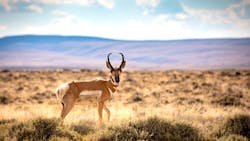Every year thousands of pronghorn and other animals migrate north and south a distance of about 150 miles between Grand Teton National Park and upper Green River Basin. In 2008 the migration path became the nation’s first federally designated wildlife migration corridor. Funneling through an area called Trappers’ Point, the corridor crosses paths with U.S. 191, near the town of Pinedale, Wyoming.
As in many parts of the U.S., Wyoming’s highway system is conflicting with its wildlife migration paths, which are thousands of years old. At Trappers’ Point alone, the Wyoming DOT (WYDOT) had at one time estimated about $500,000 per year in vehicular and wildlife resource costs due to collisions between vehicles and wildlife. The Wyoming Game and Fish Department has said that in recent decades around 140 animals per year have been struck by vehicles along this 12-mile stretch of U.S. 191.
To lower the risk to wildlife and people, as well as to reduce the annual cost of accidents, WYDOT and Wyoming Game & Fish have collaborated on a long-term initiative to increase the separation between migrating animals and roadway traffic in dozens of locations around the state.
Trappers’ Point was one of the earlier locations to be addressed, around 2012. Six animal underpasses and two overpasses were constructed by Reiman Corp. along the 12-mile length of U.S. 191. One of the factors in building an underpass versus an overpass involved the study of migration habits of different species, and whether they are more inclined to travel through or on top of a structure.
About 6.5 miles apart on U.S. 191, the overpasses were designed as concrete arch bridges, about 40 ft tall and 150 ft wide. Reinforced Earth mechanically stabilized earth (MSE) spandrel walls were installed on both sides. The concrete facing panels for the walls were cast with a stone architectural finish and painted to blend into the surrounding environment.
The MSE walls provided an ideal and attractive solution for the remote area—allowing for easy site delivery, minimized earthwork, and use of local material within the volume.
From the WYDOT website, other measures were incorporated with the overpasses. Just behind the coping, earth berms prevent the animals from seeing the highway below them. Fencing along the top of the walls was installed to prevent animals from accidentally falling off the bridge. The ground surface on top of the overpasses was planted with native soil and grass. Fencing along the 12-mile corridor act to direct the animals to the crossings.
The project at Trappers’ Point has reduced vehicle collisions with animals by about 80%, according to WYDOT. As Wyoming and other states continue to build wildlife crossings such as this one, it will allow for the conservation of the vital migration habits of pronghorn and other North American species.

